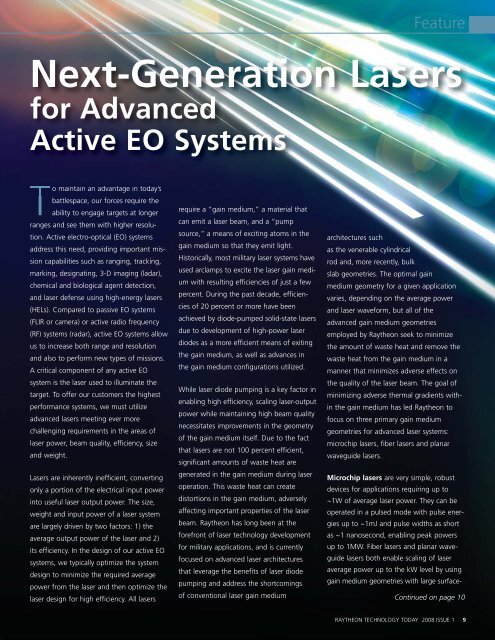Technology Today issue 1 2008 - Raytheon
Technology Today issue 1 2008 - Raytheon
Technology Today issue 1 2008 - Raytheon
You also want an ePaper? Increase the reach of your titles
YUMPU automatically turns print PDFs into web optimized ePapers that Google loves.
To maintain an advantage in today’s<br />
battlespace, our forces require the<br />
ability to engage targets at longer<br />
ranges and see them with higher resolution.<br />
Active electro-optical (EO) systems<br />
address this need, providing important mission<br />
capabilities such as ranging, tracking,<br />
marking, designating, 3-D imaging (ladar),<br />
chemical and biological agent detection,<br />
and laser defense using high-energy lasers<br />
(HELs). Compared to passive EO systems<br />
(FLIR or camera) or active radio frequency<br />
(RF) systems (radar), active EO systems allow<br />
us to increase both range and resolution<br />
and also to perform new types of missions.<br />
A critical component of any active EO<br />
system is the laser used to illuminate the<br />
target. To offer our customers the highest<br />
performance systems, we must utilize<br />
advanced lasers meeting ever more<br />
challenging requirements in the areas of<br />
laser power, beam quality, efficiency, size<br />
and weight.<br />
Lasers are inherently inefficient, converting<br />
only a portion of the electrical input power<br />
into useful laser output power. The size,<br />
weight and input power of a laser system<br />
are largely driven by two factors: 1) the<br />
average output power of the laser and 2)<br />
its efficiency. In the design of our active EO<br />
systems, we typically optimize the system<br />
design to minimize the required average<br />
power from the laser and then optimize the<br />
laser design for high efficiency. All lasers<br />
require a “gain medium,” a material that<br />
can emit a laser beam, and a “pump<br />
source,” a means of exciting atoms in the<br />
gain medium so that they emit light.<br />
Historically, most military laser systems have<br />
used arclamps to excite the laser gain medium<br />
with resulting efficiencies of just a few<br />
percent. During the past decade, efficiencies<br />
of 20 percent or more have been<br />
achieved by diode-pumped solid-state lasers<br />
due to development of high-power laser<br />
diodes as a more efficient means of exiting<br />
the gain medium, as well as advances in<br />
the gain medium configurations utilized.<br />
While laser diode pumping is a key factor in<br />
enabling high efficiency, scaling laser-output<br />
power while maintaining high beam quality<br />
necessitates improvements in the geometry<br />
of the gain medium itself. Due to the fact<br />
that lasers are not 100 percent efficient,<br />
significant amounts of waste heat are<br />
generated in the gain medium during laser<br />
operation. This waste heat can create<br />
distortions in the gain medium, adversely<br />
affecting important properties of the laser<br />
beam. <strong>Raytheon</strong> has long been at the<br />
forefront of laser technology development<br />
for military applications, and is currently<br />
focused on advanced laser architectures<br />
that leverage the benefits of laser diode<br />
pumping and address the shortcomings<br />
of conventional laser gain medium<br />
Feature<br />
Next-Generation Lasers<br />
for Advanced<br />
Active EO Systems<br />
architectures such<br />
as the venerable cylindrical<br />
rod and, more recently, bulk<br />
slab geometries. The optimal gain<br />
medium geometry for a given application<br />
varies, depending on the average power<br />
and laser waveform, but all of the<br />
advanced gain medium geometries<br />
employed by <strong>Raytheon</strong> seek to minimize<br />
the amount of waste heat and remove the<br />
waste heat from the gain medium in a<br />
manner that minimizes adverse effects on<br />
the quality of the laser beam. The goal of<br />
minimizing adverse thermal gradients within<br />
the gain medium has led <strong>Raytheon</strong> to<br />
focus on three primary gain medium<br />
geometries for advanced laser systems:<br />
microchip lasers, fiber lasers and planar<br />
waveguide lasers.<br />
Microchip lasers are very simple, robust<br />
devices for applications requiring up to<br />
~1W of average laser power. They can be<br />
operated in a pulsed mode with pulse energies<br />
up to ~1mJ and pulse widths as short<br />
as ~1 nanosecond, enabling peak powers<br />
up to 1MW. Fiber lasers and planar waveguide<br />
lasers both enable scaling of laser<br />
average power up to the kW level by using<br />
gain medium geometries with large surface-<br />
Continued on page 10<br />
RAYTHEON TECHNOLOGY TODAY <strong>2008</strong> ISSUE 1 9

















